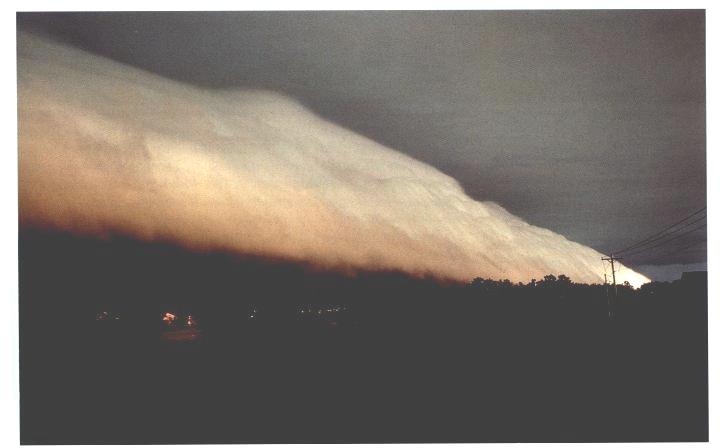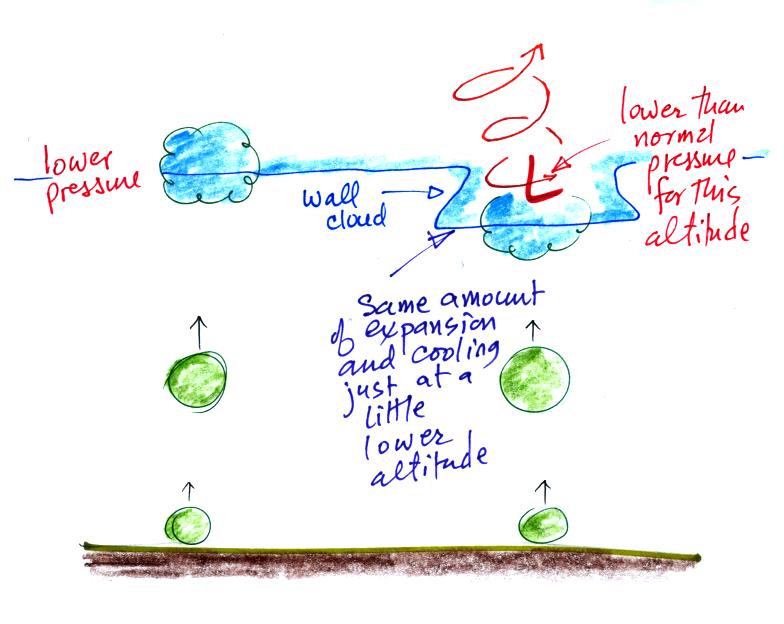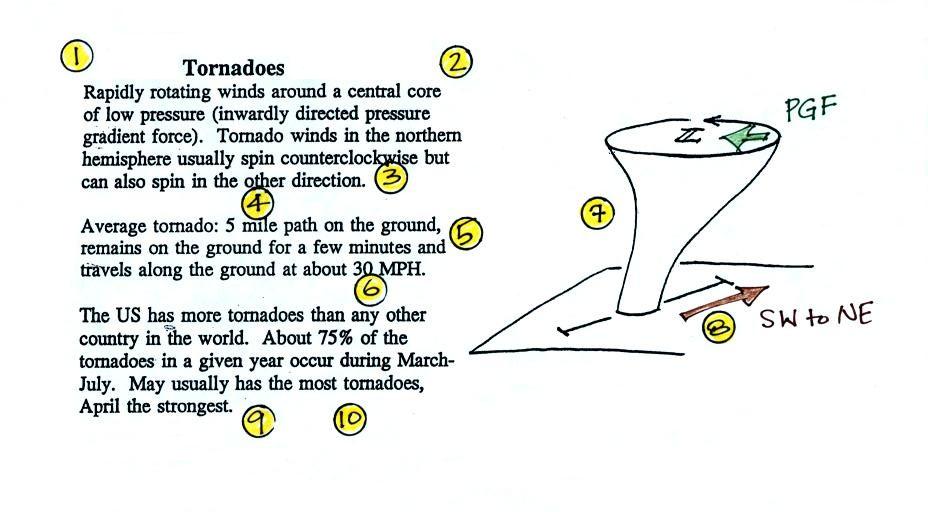Wed., Apr. 17, 2013
click here to download today's notes
in a more printer friendly format
I was watching The Voice the other night and heard a song I
liked. It turned out to be "You Know That
I'm No Good" and you heard Amy Winehouse's
version before class this afternoon.
The 1S1P worksheet on Atmospheric Stability has been graded and
was returned today. People either understood that topic or
didn't. I'll try to put some answers online, though it isn't
material you need to be concerned about for next week's quiz. The
Foucault Pendulum reports were collected today. I'll decide
by Friday whether to post any more new topics.
Part 1 and Part 2 of the Quiz #4 Study Guide
are now online.
We need to finish a little material on thunderstorms before moving
on to tornadoes today. I showed the last of my homemade
videos, a microburst demonstration.
In the video a
large plastic tank was filled with water,
the water represents air in the atmosphere. Then a
colored mixture of water and glycerin, which is a little
denser than water, is poured into the tank. This
represents the cold dense air in a thunderstorm
downdraft. The colored liquid sinks to the bottom of
the tank and then spreads out horizontally. In the
atmosphere the cold downdraft air hits the ground and
spreads out horizontally. These are the strong winds
that can reach 100 MPH. This is sketched below.
Here's
a link to the
video of a microburst that I showed in class today. It
takes innocently enough with falling precipitation some distance
away (first 2 minutes or so of the video). Strong winds and
hail reach the house where the video is being filmed about 3
minutes into the video and things turn pretty violent. A
survey of damage near the end of the video shows a tree snapped in
half by the microburst winds.
A sketch and a photograph of a
shelf cloud. Warm moist air
if lifted by the cold air behind the gust front which is
moving from left to right. The shelf
cloud is very close to the ground, so the warm air must
have been very moist because it didn't have to rise very
far before it had cooled enough to become saturated and
form a cloud. Here are a
couple of pretty good videos of shelf clouds (Grand Haven,
MI and Massillon,
OH)
Next we need to look at some of the conditions that can lead to
severe thunderstorm formation and some of the characteristics of
these storms. Severe thunderstorms last longer, grow bigger,
and become stronger than ordinary air mass thunderstorms.
They can also produce tornadoes.

Severe storms are more likely to form
when there is vertical wind shear (the picture above is on p.
154a in the ClassNotes). Wind shear (Point 1) is changing wind
direction and/or wind speed with distance. In the case
shown above, the wind speed is increasing with increasing
altitude, this is vertical wind shear.
A thunderstorm that forms in this kind of an environment will move at an average of
the speeds at the top and bottom of the cloud (pt. 2).
The thunderstorm will move to the right more rapidly than the
air at the ground which is where the updraft begins.
Rising air that is situated at the front bottom edge of the
thunderstorm will find itself at the back edge of the storm
when it reaches the top of the cloud.
This produces a tilted updraft (pt.
3). The downdraft is situated at the back of the
ground. The updraft is continually moving to the right
and staying away from the downdraft. The updraft and
downdraft coexist and do not "get in each others way."
If you remember in air mass thunderstorms, the downdraft gets
in the way of the updraft and leads to dissipation of the
storm.
Sometimes
the tilted updraft will begin to rotate. A rotating
updraft is called a mesocyclone (pt. 4). Meso refers to medium size
(thunderstorm size) and cyclone means winds spinning around
low pressure (tornadoes are sometimes called cyclones).
Low pressure in the core of the mesocyclone
creates an inward pointing pressure gradient force needed to
keep the updraft winds spinning in circular path.
The cloud that extends below the cloud
base and surrounds the mesocyclone
is called a wall cloud
(pt. 5). The largest and strongest tornadoes will
generally come from the wall cloud. We'll see some
pretty dramatic videos of wall clouds on Monday.
Note (pt. 6) that a tilted updraft also provides a way of
keeping growing hailstones inside the cloud. Hailstones
get carried up toward the top of the cloud where they begin to
fall. But they then fall back into
the strong core of the updraft and get carried back up
toward the top of the cloud.
A wall cloud can form a little bit below the rest of the base
of the thunderstorm. Clouds form when air rises, expands,
and cools as shown above at left. The rising air expands
because it is moving into lower pressure surroundings at higher
altitude. Only when the air has risen high enough, moved
into low enough pressure, expanded and cooled enough will a cloud
form.
At right the air doesn't have to rise to as high an altitude to
experience the same amount of expansion and cooling. This is
because it is moving into the core of the rotating updraft where
the pressure is a little lower than normal for this
altitude. Cloud formation is a little bit closer to the
ground.
Here's a picture of a portion of the bottom of a
thunderstorm with a wall cloud and, what appears to be, a
relatively weak tornado (narrow diameter and almost
transparent). Photo from
the University Corporation for Atmospheric Research
Now on to tornadoes.
The United States has roughly 1000 tornadoes
in an average year. That is more than any
other country in the world .
A year's worth of tornado
activity plotted on a world map. Note the name
at bottom left: T.T. Fujita. The scale used to
rate tornado strength and intensity is named after
him.
Part of the reason why the central
US
has
some
many
tornadoes
is
just a consequence of geography.

Without any mountains in the
way, cold dry air can move in the spring all the way
from Canada to the Gulf Coast. There it collides
with warm moist air from the Gulf of Mexico to form
strong cold fronts and thunderstorms. There are
some other meteorological conditions that come into play
that make these storms capable of producing tornadoes.

This map (found on p. 161 in the
ClassNotes) shows the average frequency of tornado
occurrence in the US. Tornadoes have been observed
in every state (including Alaska), but they are most
frequent in the Central Plains, a region referred to as
"Tornado Alley" (highlighted in red, orange, and yellow
above).
Here are some basic tornado characteristics (the
figure above is also on p. 161)
1. About 2/3rds of tornadoes are F0 or F1
tornadoes (this is referring to the Fujita Scale, which we'll
learn more about on Friday) and have spinning winds of about
100 MPH or less. Microburst winds can also reach 100
MPH. Microbursts are much more common in Tucson in the
summer than tornadoes and can inflict the same level of
damage.
2. A very strong inwardly directed pressure
gradient force is needed to keep winds spinning in a circular
path. The pressure in the center core of a tornado can
be 100 mb less than the pressure in the air outside the
tornado. This is a very large pressure difference in
such a short distance. The
PGF
is
much
stronger
than
the
Coriolis
Force
(CF)
and
the
CF
can
be
neglected.
The same pressure drop can be found in strong hurricanes but
it takes place over a much larger distance. The PGF
isn't as strong and the CF does play a role.
3. Because the Coriolis force doesn't play a
role, tornadoes can spin clockwise or counterclockwise, though
counterclockwise rotation is more common. This might be
because larger scale motions in the cloud (where the CF is
important, might determine the direction of spin in a
tornado).
4, 5, 6. Tornadoes usually last only a few
minutes, leave a path on the ground that is a few
miles long, and move at a few 10s of MPH.
There are exceptions, we'll look at one shortly.
7, 8. Most tornadoes move from the SW toward
the NE. This is because tornado-producing thunderstorms
are often found just ahead of a cold front where winds often
blow from the SW. Most
tornadoes
have
diameters
of
tens
to
a
few
hundred
yards
but
tornadoes
with
diameters
over
a
mile
have
been
observed.
Tornado diameter can also can a lot between the ground and the
base of the thunderstorm.
9, 10. Tornadoes
are
most
frequent
in
the
Spring.
The
strongest
tornadoes
also
occur
at
that
time
of
year.
You
don't need to remember the specific months. Tornadoes
are most common in the late afternoon when the atmosphere is
most unstable.
A
little more infomation on p. 161 that wasn't mentioned in class.
At
the present time about 75 people are killed every year in the
United States by tornadoes. This is about a factor of ten
less than a century ago due to improved methods of detecting
tornadoes and severe thunderstorms. Modern day
communications also make easier to warm people of dangerous
weather situations. Lightning and flash floods (floods are
the most serious severe weather hazard) kill slightly more people
than tornadoes. Hurricanes kill fewer people on average than
tornadoes. The increase in the number of tornadoes observed
per year is probably more due to there being more people in
locations that are able to observe and report a tornado rather
than a true increase in tornado activity.

This figure traces
out the path of the 1925 "Tri-State
Tornado" . The tornado path (note the SW to NE
orientation) was 219 miles long, the tornado lasted about
3.5 hours and killed 695 people. The tornado was
traveling over 60 MPH over much of its path. It is still
today the deadliest single tornado ever in the United States
(you'll find a compilation of tornado records here).
The Joplin
Missouri tornado (May 22, 2011) killed 162 people making
it the deadliest since 1947 and the 7th deadliest tornado in US
history.
Tornadoes often
occur in "outbreaks." The paths of 148 tornadoes
during the April 3-4, 1974 "Jumbo
Tornado Outbreak" are shown above. Note
the first tornadoes were located in the upper left
corner of the map and all of the tornado paths are
oriented from SW to NE.
The April
25-28, 2011 outbreak is now apparently the largest
tornado outbreak in US history (358 tornadoes, 346 people
killed)
As we learn more about tornadoes I'm hoping you'll
look at video with a more critical eye than you would have
otherwise. So we took a moment, at this point, to
have a look at some tornadoes caught on video. If you
click on the links you'll see the same or a similiar video
that I found online. The videos shown in class were from
a tape called "Tornado
Video Classics"
54a
|
F3
|
Grand Isle NE
|
Mar. 13, 1990
|
tornado cloud is pretty
thick and vertical |
61f
|
F3
|
McConnell
AFB
KS
|
Apr. 26, 1991
|
this is about as close
to a tornado as you're ever likely to get. Try to
judge the diameter of the tornado cloud. What
direction are the tornado winds spinning?
|
52
|
F5
|
Hesston
KS
|
Mar. 13, 1990
|
Watch closely, you may
see a tree or two uprooted by the tornado winds
|
51
|
F3
|
North
Platte
NE
|
Jun. 25, 1989
|
Trees uprooted and
buildings lifted by the tornado winds. The online
video is longer than the one shown in class and has some
good closeup video. See especially the last couple
of minutes of the video
|
65
|
F1
|
Brainard
MN
|
Jul. 5, 1991
|
It's a good thing this
was only an F1 tornado
|
57
|
F2
|
Darlington
IN
|
Jun. 1, 1990
|
Tornado cloud without
much dust
|
62b
|
F2
|
Kansas
Turnpike
|
Apr. 26, 1991
|
It's sometimes hard to
run away from a tornado. Watch closely you'll see a
van blown off the road and rolled by the tornado.
The driver of the van was killed!
|
47
|
F2
|
Minneapolis
MN
|
Jul. 18, 1986
|
Tornado cloud appears
and disappears. The online video compares features
seen in this tornado with one created in a laboratory.
|
The online Kansas
turnpike video also has a warning that a highway underpass
is actually a very dangerous place to take shelter from a
tornado. Here is some
additional information from the Norman OK office of the
National Weather Service. Slide 6 lists some of the reasons
why underpasses are so dangerous.
More tornado videos coming on Friday.













